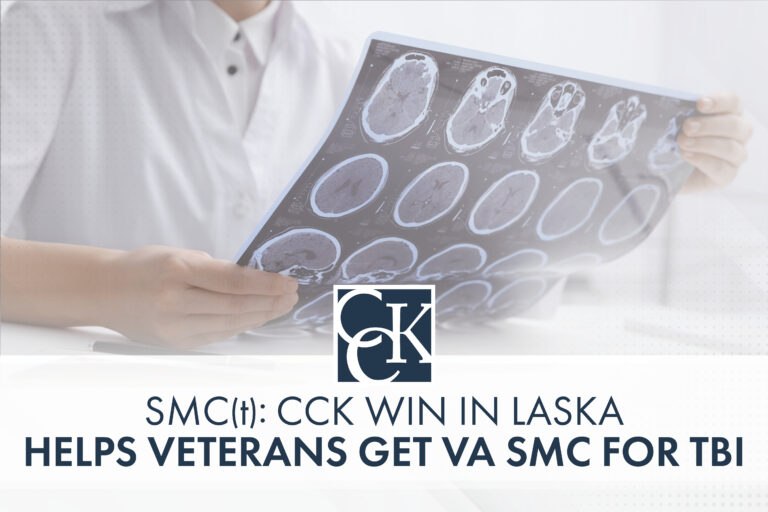SMC(t): CCK Win in Laska Helps Veterans Get VA SMC for TBI

CCK Law: Our Vital Role in Veterans Law
This analysis of Margaret Laska v. Denis McDonough, No. 22-1018, 2024 WL 4096538, at *8 (Vet.App. Sept. 6, 2024), is based in part on interviews with Amy F. Odom, Zachary M. Stolz, and April Donahower of Chisholm Chisholm & Kilpatrick, who represented the appellant.
Veterans Affairs (VA) pays monthly compensation to veterans who have a current disability resulting from their military service. For most disabled veterans, VA applies the criteria in the Schedule for Rating Disabilities to arrive at a base rating that represents “the average impairment in earning capacity” for the service-connected disability. The rating then determines the amount of monthly compensation.
Alternatively (or, in specific cases, in addition to regular disability compensation), special monthly compensation (SMC) is available to veterans whose service-connected disabilities resulted in “additional hardships above and beyond those contemplated by VA’s schedule for rating disabilities.” The rate of SMC “varies according to the nature of the veteran’s service-connected disabilities.” The available SMC levels are defined by subsections of 38 U.S.C. § 1114.
38 U.S.C. § 1114(t)—or SMC(t)—provides SMC to a veteran (1) in need of regular aid and attendance for the service-connected residuals of traumatic brain injury (TBI); (2) not eligible for a higher level of aid and attendance under 38 U.S.C. § 1114(r)(2); and (3) who, in the absence of such aid and attendance, would require hospitalization, nursing home care, or other residential institutional care.

38 C.F.R. § 3.352(b)(2) and VA’s “higher level of care” standard
38 C.F.R. § 3.352(b)(2), the VA regulation that implements 38 U.S.C. § 1114(t), requires that to be entitled to SMC(t), a veteran must need a higher level of care (e.g., aid and attendance by medical professionals).
Veterans and advocates have argued that this regulation led to there being no meaningful difference between SMC(t) and 38 U.S.C. § 1114(r)(2), which also requires a higher level of care. VA’s extra-statutory requirement of a need for a higher level of care had invalidated SMC(t) and Congress’ intent that victims of severe TBIs receive special consideration.
In Laska v. McDonough, Chisholm Chisholm & Kilpatrick asked the U.S. Court of Appeals for Veterans Claims (CAVC) to consider whether 38 C.F.R. § 3.352(b)(2) was contrary to 38 U.S.C. § 1114(t) in requiring a higher level of care over and above regular aid and attendance. On behalf of the appellant, CCK argued that the plain language of 38 U.S.C. § 1114(t) clearly does not require that the veteran need a higher level of care in addition to regular aid and attendance. In response, VA argued that the statute was not clear and that § 3.352(b) clarifies ambiguity as to whether SMC(t) requires a higher level of care.
Facts of Case
Mr. Herbert N. Haskell, II, suffered a head injury while serving in Vietnam in May 1967. He was awarded service connection for encephalopathy with left cerebellar dysfunction and loss of part of the skull with retained metallic bodies. In July 2008, Mr. Haskell filed a claim for an increased rating and SMC. At first, VA awarded a total rating of 100 percent and SMC(s), as provided by 38 U.S.C. § 1114(s). VA later awarded SMC based on the need for regular aid and attendance under 38 U.S.C. § 1114(r)(1).
In May 2017, Mr. Haskell claimed service connection for TBI. VA denied his claim and appeal for SMC(t), deciding in January 2022 that while the veteran required regular aid and attendance, he did not need at-home, daily, personal services provided by a licensed healthcare professional, as required by 38 C.F.R. § 3.352(b).
Haskell appealed to CAVC, arguing that 38 C.F.R. § 3.352(b)(2) conflicts with the governing statute, 38 U.S.C. § 1114(t). While the case was pending, Haskell died. His wife, Margaret Laska, was substituted.
The Court’s Opinion
Loper Bright
The Court opened by citing Loper Bright Enterprises v. Raimondo, 144 S.Ct. 2244 (2024), a landmark Supreme Court decision that overturned the longstanding “Chevron doctrine,” which had granted significant deference to agencies’ reasonable interpretation of ambiguous statutes. The Court quoted Loper, “Courts interpret statutes, no matter the context, based on the traditional tools of statutory construction.’ Loper Bright, 144 S.Ct. at 2268.” The Court also noted: “Courts must also exercise their independent judgment in deciding whether an agency has acted within its statutory authority.”
Plain Language of 38 U.S.C. § 1114(t)
Next, the Court considered the plain language of the statute. The Court noted that when looking at a statute, a court should “look first to its language, giving the words used their ordinary meaning.’ Cowan v. McDonough, 35 Vet.App. 232, 238 (2022) (quoting Artis v. Dist. of Columbia, 583 U.S. 71, 83 (2018)); see Frederick v. Shinseki, 684 F.3d 1263, 1269 (Fed. Cir. 2012).” Additionally, “‘the plain meaning of any statutory provision must be determined in light of the statutory scheme as a whole, the specific context in which the word or provision at issue is used, and the broader context of the statute as a whole’.”
The Court described 38 U.S.C. § 1114(t) as imposing multiple requirements, with the first clearly describing the need for regular aid and attendance. The court observed that while the second requirement does reference subsection (r)(2), it does not specify the level of care needed for SMC(t), only who is eligible to receive SMC(t)—”namely, veterans who do not qualify for SMC(r)(2). … This explicit reference to subsection (r)(2) thus distinguishes that subsection from subsection (t) rather than borrowing from it.”
The Court found this significant because “‘[w]here Congress includes particular language in one section of a statute but omits it in another section of the same Act, it is generally presumed that Congress acts intentionally and purposely in the disparate inclusion or exclusion.’ [Russello v. United States, 464 U.S. 16, 23] (quoting United States v. Wong Kim Bo, 472 F.2d 720, 722 (5th Cir.1972)).” The Court then stated, “Given this deliberate choice by Congress, we will not read into section 1114(t) an additional higher-level requirement that is not apparent on its face or consistent with the statutory scheme as a whole.”
The Court concluded by finding it legally significant that 38 U.S.C. § 1114(t) makes logical sense this way, “unlike the Secretary’s strained interpretation of the text and structure of section 1114(t).”
Legislative Intent of 38 U.S.C. § 1114(t)
The Court continued its analysis by considering legislative intent. “[L]egislative history may help clarify or confirm the meaning of statutory provisions. See, e.g., Alleman v. Principi, 349 F.3d 1368, 1371-72 (Fed. Cir. 2003) (consulting the legislative history despite finding the statute clear).”
For evidence of Congress’ intent, the Court highlighted comments by the Senate Committee that produced the statute’s language, including comments stating that veterans with TBI are not always provided the same level of compensation as a veteran with physical disability, and that this should be corrected by considering both “medical or non-medical assistance” as relevant. The Court found that the Senate Committee also believed that veterans with TBI may require 24-hour care; supervision for safety; assistance with most higher-level activities; prompting or much longer time to perform activities of daily living than they did pre-injury; more need assistance with tasks they can no longer perform; and someone to facilitate tasks they cannot keep up with. Furthermore, the Committee believed that such assistance can be provided by a family member rather than a licensed healthcare professional.
In concluding its analysis of legislative history, the Court agreed with Ms. Laska’s observation that Congress explicitly defined a higher level of care requirement as involving “daily, personal, health-care services by a licensed health-care professional” while legislating 38 U.S.C. § 1114(r)(2) but not when legislating subsection (t). The Court accepted this omission as evidence of intent.
CAVC’s Conclusion:
“In conclusion, section 1114(t) specifies that the requisite level of care for entitlement to SMC(t) is the need for regular aid and attendance and the Secretary’s implementing regulation, § 3.352(b)(2), requires the higher-level care described in 1114(r)(2). Thus, the regulation exceeds its authorizing statute and must be set aside as invalid.”
The Court vacated the January 2022 Board decision and remanded the matter for any necessary additional development and then readjudication.
Potential Impact of Laska
Easier Access to SMC(t)
Congress created SMC(t) in recognition that although the invisible wounds of a TBI are different from the physical impairments that lead to the highest rate of SMC under 38 U.S.C. 1114(r)(2), they should still be compensated at the same rate. VA’s extra-statutory requirement of a need for a higher level of care blocked this intent. The Court has now invalidated that extra-statutory requirement.
As a result, veterans who are severely disabled by traumatic brain injury will now receive the special monthly compensation that Congress intended them to receive.
Relevance for Many OEF/OIF Veterans
Even though Mr. Haskell was a Vietnam veteran, Congress has deemed TBI a “signature wound” of Operation Enduring Freedom in Afghanistan and Operation Iraqi Freedom, so the Laska decision will likely impact many other veterans.
More Improvements to Regulations
Laska was one of the first CAVC cases to be decided since the Supreme Court’s decision in Loper Bright. Loper Bright made it easier for CAVC to reject 38 C.F.R. § 3.352(b)(2) and VA’s “higher level of care” standard. The Court’s approach and decision in Laska suggest that it is willing and likely to examine other VA regulations that have been questioned for similar reasons. Other vague and counter-productive regulations may soon get their day in court thanks to Loper Bright.
About the Author
Share this Post
